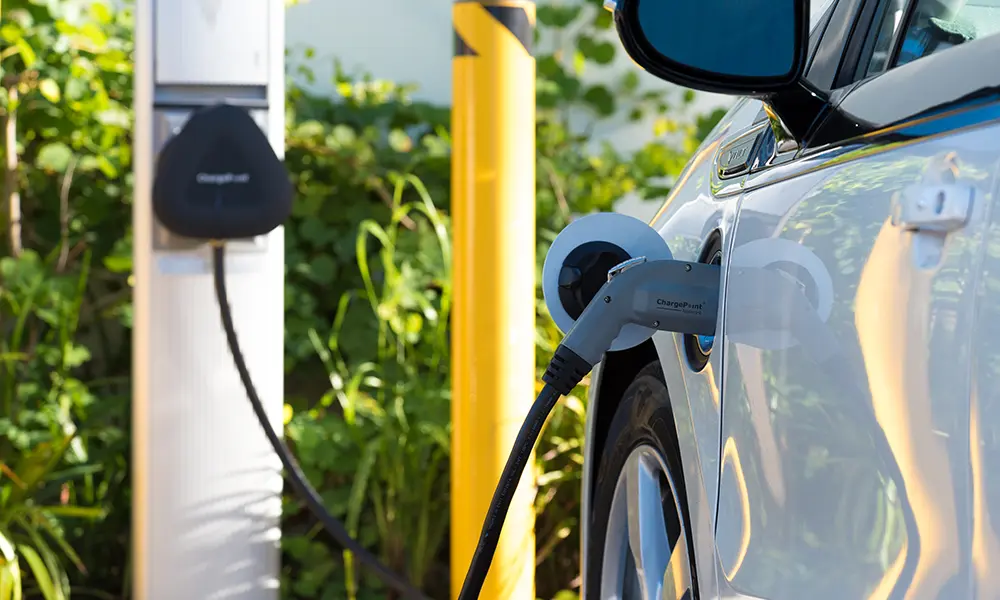
Pourquoi les entreprises doivent-elles verdir leur flotte de véhicules ?
Le marché de l’automobile se voit bouleversé par les mesures prises, avec notamment la fin annoncée par l’UE de la vente de véhicules neufs à moteur thermique à l’horizon 2035. D’autre part, la LOM envisage une neutralité carbone des transports terrestres d’ici 2050.
Ce plan ambitieux mais essentiel a pour but de lutter contre le réchauffement climatique et de préserver la biodiversité ; mais vise également à améliorer la qualité de l’air et diminuer la pollution sonore.
Les entreprises doivent donc anticiper ces changements, notamment au moment du renouvellement de la flotte, et engager dès maintenant leur transition vers une mobilité plus propre.
Une nouvelle vision de la mobilité

Verdissement des flottes automobiles
- Les entreprises privées ayant plus de 100 véhicules en parc, doivent, depuis le 1er janvier 2024, intégrer au moins 20% de véhicules à faibles émissions (VFE) dans leur renouvellement annuel. Ce quota devra être de 35% en 2027 et atteindre 50% en 2030.
- Plusieurs solutions de mobilité s’offrent aux entreprises pour verdir leur parc automobile : énergies vertes, véhicules électriques, offres de mobilité en libre-service comme l’autopartage… La télématique vous aide à optimiser la taille et les trajets de votre flotte, et à sensibiliser vos conducteurs à l’écoconduite pour éviter les surconsommations énergétiques.

Focus sur les véhicules électriques
- Tarification adaptée selon le niveau des émissions de carbone, notamment sur les autoroutes.
- Objectif de 7 Millions de bornes de recharge en 2030 sur le territoire (voies publiques, parkings et bâtiments).
- De plus, les entreprises bénéficient de nombreuses aides pour passer à l’électrique : prime à la conversion, bonus écologique, exonération sur les certificats d’immatriculation, Taxe sur les Véhicules de Société (TVS) réduite, abattement de l’avantage en nature.

La question de l’autopartage
- Possibilité d’établissement d’un label autopartage aux véhicules dédiés à cette activité (selon des critères fixés par l’AOM).
- Les véhicules détenteurs du label peuvent bénéficier de places de stationnement réservées.
- Un véhicule autopartagé remplace 5 à 8 véhicules individuels et permet aux entreprises de réaliser de réelles économies.

Le vélo comme futur moyen de transport
- Amélioration des infrastructures et massification des aménagements cyclables
- Prise en compte des enjeux de sécurité routière
- Lutte contre le vol de vélos
- Apprentissage systématisé en école primaire
- Indemnité kilométrique vélo
- Verdissement des flottes automobiles
Verdissement des flottes automobiles
Vers une diminution des émissions de CO2 grâce à des véhicules de plus en plus propres :- Les entreprises privées ayant plus de 100 véhicules en parc, doivent, depuis le 1er janvier 2024, intégrer au moins 20% de véhicules à faibles émissions (VFE) dans leur renouvellement annuel. Ce quota devra être de 35% en 2027 et atteindre 50% en 2030.
- Plusieurs solutions de mobilité s’offrent aux entreprises pour verdir leur parc automobile : énergies vertes, véhicules électriques, offres de mobilité en libre-service comme l’autopartage… La télématique vous aide à optimiser la taille et les trajets de votre flotte, et à sensibiliser vos conducteurs à l’écoconduite pour éviter les surconsommations énergétiques.
- Les véhicules électriques
Focus sur les véhicules électriques
Des adaptations pour faciliter les nouveaux acquéreurs :- Tarification adaptée selon le niveau des émissions de carbone, notamment sur les autoroutes.
- Objectif de 7 Millions de bornes de recharge en 2030 sur le territoire (voies publiques, parkings et bâtiments).
- De plus, les entreprises bénéficient de nombreuses aides pour passer à l’électrique : prime à la conversion, bonus écologique, exonération sur les certificats d’immatriculation, Taxe sur les Véhicules de Société (TVS) réduite, abattement de l’avantage en nature.
- L’autopartage
La question de l’autopartage
Faire le choix d’une flotte de véhicules accessibles en libre-service :- Possibilité d’établissement d’un label autopartage aux véhicules dédiés à cette activité (selon des critères fixés par l’AOM).
- Les véhicules détenteurs du label peuvent bénéficier de places de stationnement réservées.
- Un véhicule autopartagé remplace 5 à 8 véhicules individuels et permet aux entreprises de réaliser de réelles économies.
- Le vélo
Le vélo comme futur moyen de transport
Vers une utilisation du vélo pour les trajets domicile-travail et dans le cadre du travail plus répandu :- Amélioration des infrastructures et massification des aménagements cyclables
- Prise en compte des enjeux de sécurité routière
- Lutte contre le vol de vélos
- Apprentissage systématisé en école primaire
- Indemnité kilométrique vélo
Les mesures pour encourager une mobilité plus respectueuse de l’environnement
Mise en place des systèmes de transports intelligents :
Création d’un forfait mobilités durables :
prise en charge par l’employeur des frais de déplacements domicile travail (vélo, VAE, service de mobilité partagé, covoiturage, autopartage à faible émission, transports publics hors abonnement) :